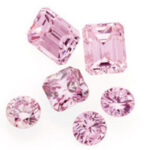“Every diamond in De Beers Diamond Jewellery is conflict-free and child labour free.”
For many Americans, clarity and size are the two most important considerations when choosing a diamond. These folks have little concern beyond fulfilling the status quo or pleasing their eager fiancés. A select few, however, are much more interested in where their diamonds come from. For them, the above De Beers promise is the most important one a diamond company can make. These Americans are well aware of the horrifying nature of the conflict diamond industry and need reassurance that no blood had been spilled in the manufacturing of their precious gem.
Blood or conflict diamonds, aptly named due to the vicious nature in which they are obtained, are described by the United Nations as “…diamonds that originate from areas controlled by forces or factions opposed to legitimate and internationally recognized governments, and are used to fund military action in opposition to those governments, or in contravention of the decisions of the Security Council.” Diamonds such as these, received international attention during the mid nineties as a result of bloody conflict in Sierra Leone. At that time, conflict diamonds accounted for about 4% of all diamonds. Since the enactment of the Kimberly Process, that number has been reduced to about 1%. The Republic of Congo, Liberia and the Ivory Coast are the three countries responsible for that small, yet significant percent.
The Kimberly Process Certification System, a UN backed system, was enacted in 2002 following a global outcry against blood diamonds. Both governmental and non-governmental organizations teamed up with the diamond industry to create a process that has since reduced the wide-scale manufacturing and distribution of blood diamonds. In fact, Diamondfacts.org found that the Kimberly Process was largely responsible for diamonds now accounting for much of the economic growth in Africa.
Diamondfacts.org provides a number of facts on their website that demonstrate the positive effects of diamonds, including,
(1) An estimated 5 million people have access to appropriate healthcare globally thanks to revenues from diamonds.
(2) Diamond revenues enable every child in Botswana to receive free education up to the age of 13.
(3) An estimated 10 million people globally are directly or indirectly supported by the diamond industry.
(4) The charity Jewelers for Children funds a community based care program for orphaned children in South Africa.
(5) The diamond mining industry generates over 40% of Namibia’s annual export earnings.
(6) The Diamond Development Initiative was established to improve the working conditions of artisanal miners.
(7) Approximately one million people are employed by the diamond industry in India.
(8) Approximately $8.4 billion worth of diamonds a year come from African countries.
(9) The revenue from diamonds is instrumental in the fight against the HIV/AIDS pandemic.
(10) An estimated 65% of the world’s diamonds come from African countries.
The list goes on. In fact, by the time you have finished reading each of the 23 facts mentioned on their website, you begin to feel that purchasing a diamond is the most effective way to help Africa.
The De Beers group describes the Kimberly Process in more detail.
“The KPCS (Kimberly Process Certification System) requires participating governments to ensure that each shipment of rough diamonds exported be in a secure container and accompanied by a uniquely numbered, government-validated certificate stating that the diamonds are conflict-free. Over 45 countries participate, representing all the nations with significant involvement in the diamond trade. All 45 importing countries agree not to accept any rough diamonds without an approved Kimberley Process Certificate.”
The De Beers group will also tell you that they are responsible for creating the World Diamond Council, an organization committed to eradicating the selling of blood diamonds. In fact, Andrew Coxon, President of the De Beers Institute of Diamonds, and a founding member of the World Diamond Council apparently helped spearhead the Kimberly Process.
On the one hand, De Beers and the UN seem to have made great efforts in the war on the blood diamond industry. On the other hand, the fact that the blood diamond industry still exists in some places presents a possibility that not everyone involved is being honest. Someone is buying those diamonds; otherwise these countries would not continue to mine them. While it is also admirable that De Beers took it upon themselves to certify their diamonds, humanitarian moves do not come without some benefit to the humanitarian. Appealing to the hearts of Americans can be as strategic a business move as any.
It is hard to understand exactly what a “certified” diamond really means. At some point, you just have to trust the company you choose to invest in. I can only hope that the diamond industry is right and that diamonds are as beneficial as they would lead you to believe.






